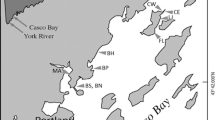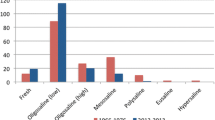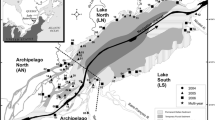Abstract
Benthic macroinvertebrate abundance, taxonomic composition, and surface flooding dynamics were compared among high and low elevation stands of narrow-leaved cattail (Typha angustifolia) and invasive common reed (Phragmites australis) at Iona Island Marsh, an oligohaline wetland, and Piermont Marsh, a mesohaline wetland, within the Hudson River National Estuarine Research Reserve during 1999 and 2000. Overall, the benthic macroinvertebrate community at both sites was similar in composition and abundance to those documented from other low-salinity systems. Macroinvertebrate taxa richness was lowest in mesohaline common reed, but similar among common reed and cattail habitats in oligohaline wetlands. Total macroinvertebrate densities were greater at high-elevation compared to low-elevation reed stands at the mesohaline site during summer 1999 and spring 2000. Total macroinvertebrate densities were similar among both oligohaline vegetation types during all seasons, except for spring 2000, when lower densities were observed in low-elevation common reed. A weak positive relationship between macroinvertebrate density and depth of flooding suggests that surface hydrology may be influencing the observed patterns of macroinvertebrate density among the vegetation stands. These results suggest that benthic macroinvertebrate abundance and diversity may not necessarily be impaired in low-salinity wetlands experiencing invasion by common reed unless the change in vegetation is accompanied by a measurable alteration to physical conditions on the marsh surface (i.e., elevation and flooding dynamics).





Similar content being viewed by others
References
Angradi, T.R., S.M. Hagan, and K.W. Able. 2001. Vegetation type and the intertidal macroinvertebrate fauna of a brackish marsh: Phragmites vs. Spartina. Wetlands 21: 75–92.
Barendregt, A., T. Ysebaert, and W.J. Wolff. 2009. Animal communities in European tidal freshwater wetlands. In Tidal freshwater wetlands, ed. A. Barendregt, D.F. Whigham, and A.H. Baldwin, 89–104. Leiden: Backhuys.
Benoit, L.K., and R.A. Askins. 1999. Impact of the spread of Phragmites on the distribution of birds in Connecticut tidal marshes. Wetlands 19: 194–208.
Chambers, R.M., L.A. Meyerson, and K. Saltonstall. 1999. Expansion of Phragmites australis into tidal wetlands of North America. Aquatic Botany 64: 261–273.
Chambers, R.M., D.T. Osgood, and N. Kalapasev. 2002. Hydrologic and chemical control of Phragmites australis growth in tidal marshes. Marine Ecology Progress Series 239: 83–91.
Diaz, R.J. 1978. Ecology of tidal freshwater and estuarine Tubificidae (Oligochaeta). In Aquatic oligochaete biology, ed. R.O. Brinkhurst and D.G. Cook, 319–330. New York: Plenum.
Diaz, R.J. 1989. Pollution and tidal benthic communities of the James River Estuary, Virginia. Hydrobiologia 180: 195–211.
Diaz, R.J. 1994. Response of tidal freshwater macrobenthos to sediment disturbance. Hydrobiologia 278: 201–212.
Diaz, R.J., D.F. Boesch, J.L. Hauer, C.A. Stone, and K. Munson. 1978. Part II, Aquatic biology—benthos. In Habitat development field investigations, windmill point development site, James River, Virginia, pp. 18–54. Technical Report TR D-77-23. US Army Engineer Waterways Experiment Station, Vicksburg.
Ettinger, W.S. 1982. Macrobenthos of the freshwater tidal Schuylkill River at Philadelphia, Pennsylvania. Journal of Freshwater Ecology 1: 599–606.
Fell, P.E., S.P. Weissbach, D.A. Jones, M.A. Fallon, J.A. Zeppieri, E.K. Faison, K.A. Lennon, K.J. Newberry, and L.K. Reddington. 1998. Does invasion of oligohaline tidal marshes by reed grass, Phragmites australis, affect the availability of prey resources for the mummichog, Fundulus heteroclitus? Journal of Experimental Marine Biology and Ecology 222: 59–77.
Fell, P.E., R.S. Warren, J.K. Light, R.L. Rawson, and S.M. Fairley. 2003. Comparison of fish and macroinvertebrate use of Typha angustifolia, Phragmites australis, and treated Phragmites marshes along the lower Connecticut River. Estuaries 26: 534–551.
Lathrop, R.G., L. Windham, and P. Montesano. 2003. Does Phragmites expansion alter the structure and function of marsh landscapes? Patterns and processes revisited. Estuaries 26: 423–435.
Marks, M., B. Lapin, and J. Randall. 1994. Phragmites australis (P. communis): Threats, management, and monitoring. Natural Areas Journal 14: 285–294.
McIvor, C.C., and W.E. Odum. 1988. Food, predation risk, and microhabitat selection in a marsh fish assemblage. Ecology 69: 1341–1351.
Meyer, D.L., J.M. Johnson, and J.W. Gill. 2001. Comparison of nekton use of Phragmites australis and Spartina alterniflora marshes in the Chesapeake Bay, USA. Marine Ecology Progress Series 209: 71–84.
Odum, W.E. 1988. Comparative ecology of tidal freshwater and salt marshes. Annual Review of Ecology and Systematics 19: 147–176.
Odum, W.E., and M.A. Heywood. 1978. Decomposition of intertidal freshwater marsh plants. In Freshwater wetlands: Ecological processes and management potential, ed. R.E. Good, D.F. Whigham, and R.L. Simpson, 89–97. New York: Academic.
Orson, R.A., R.S. Warren, and W.A. Niering. 1987. Development of a New England river valley tidal marsh. Estuaries 10: 20–27.
Osgood, D.T. 2000. Subsurface hydrology and nutrient export from barrier island marshes at different tidal ranges. Wetlands Ecology and Management 8: 133–146.
Osgood, D.T., D.J. Yozzo, R.M. Chambers, S. Pianka, C. LePage and J. Lewis. 2006. Patterns of habitat utilization by resident nekton in Phragmites and Typha marshes on the Hudson River Estuary, New York. In Hudson River fishes and their environment, eds. J. Waldman, K. Limburg, and D. Strayer. American Fisheries Society Symposium 51:151–173.
Raichel, D.L., K.W. Able, and J.M. Hartman. 2003. The influence of Phragmites (Common reed) on the distribution, abundance, and potential prey of a resident marsh fish in the Hackensack Meadowlands, New Jersey. Estuaries 26: 511–521.
Robert, L.L., and J.F. Matta. 1984. Aquatic macroinvertebrates in an irregularly flooded salt marsh: diversity and seasonal variation. Environmental Entomology 13: 1097–1104.
Rozas, L.P., and W.E. Odum. 1987. Fish and macrocrustacean use of submerged plant beds in tidal freshwater marsh creeks. Marine Ecology Progress Series 38: 101–108.
Shannon, C., and W. Weaver. 1949. The mathematical theory of communication. Urbana: University of Illinois Press.
Swarth, C.W., and E. Kiviat. 2009. Animal communities in North American tidal freshwater wetlands. In Tidal freshwater wetlands, ed. A. Barendregt, D.F. Whigham, and A.H. Baldwin, 71–88. Leiden: The Netherlands, Backhuys Publishers.
Warren, R.S., P.E. Fell, J.L. Grimsby, E.L. Buck, G.C. Rilling, and R.A. Fertik. 2001. Rates, patterns, and impacts of Phragmites australis expansion and effects of experimental Phragmites control on vegetation, macroinvertebrates, and fish within tidelands of the Lower Connecticut River. Estuaries 24: 90–107.
Weinstein, M.P., and J.H. Balletto. 1999. Does the Common reed, Phragmites australis, affect essential fish habitat? Estuaries 22: 793–802.
Wenner, E.L., and H.R. Beatty. 1988. Macrobenthic communities from wetland impoundments and adjacent open marsh habitats in South Carolina. Estuaries 11: 29–44.
Windham, L., and R.G. Lathrop. 1999. Effects of Phragmites australis (Common reed) invasion on aboveground biomass and soil properties in brackish tidal marsh of the Mullica River, New Jersey. Estuaries 22: 927–935.
Winogrond, H.G. and E. Kiviat. 1997. Invasion of Phragmites australis in the tidal marshes of the Hudson River. Section VI. In Final reports of the Tibor T. Polgar Fellowship Program, 1996, eds.W.C. Nieder and J.R. Waldman. New York: Hudson River Foundation
Yozzo, D.J., and R.J. Diaz. 1999. Tidal freshwater wetlands: invertebrate diversity, ecology and functional significance. In Invertebrates in freshwater wetlands of North America: Ecology and management, eds. D. Batzer, R. Rader, and S. Wissinger. New York: Wiley.
Yozzo, D.J., and D.E. Smith. 1995. Seasonality, abundance, and microhabitat distribution of meiofauna from a Chickahominy River, Virginia tidal freshwater marsh. Hydrobiologia 310: 197–206.
Yozzo, D.J., and D.E. Smith. 1998. Composition and abundance of resident marsh-surface nekton: comparison between tidal freshwater and salt marshes in Virginia, USA. Hydrobiologia 362: 9–19.
Yozzo, D.J., and P.L. Steineck. 1994. Ostracoda from tidal freshwater wetlands at Stockport, Hudson River Estuary: Abundance, distribution, and composition. Estuaries 17: 680–684.
Acknowledgments
Funding for this study was provided by the Hudson River Research Grant Program of the Hudson River Foundation. The authors appreciate the logistical support of Chuck Nieder, former Research Coordinator of the Hudson River National Estuarine Research Reserve, and the cooperation of the Palisades Interstate Park Commission. Field, laboratory, and graphics assistance was provided by C. Miller, L. Vasilakos, C. Elliot, S. Matteson, R. Murphy, and C. Cotroneo. Comments by Aat Barendregt, Chris Swarth and two anonymous reviewers improved the quality and accuracy of the final manuscript.
Author information
Authors and Affiliations
Corresponding author
Rights and permissions
About this article
Cite this article
Yozzo, D.J., Osgood, D.T. Invertebrate Communities of Low-Salinity Wetlands: Overview and Comparison between Phragmites and Typha Marshes Within the Hudson River Estuary. Estuaries and Coasts 36, 575–584 (2013). https://doi.org/10.1007/s12237-012-9543-6
Received:
Revised:
Accepted:
Published:
Issue Date:
DOI: https://doi.org/10.1007/s12237-012-9543-6




